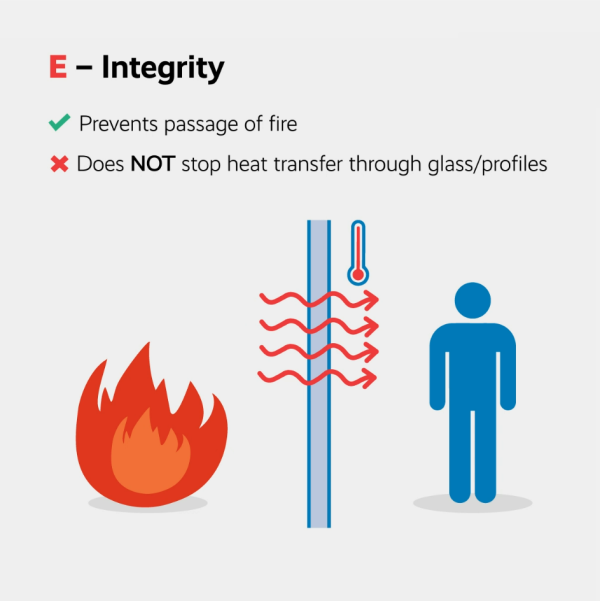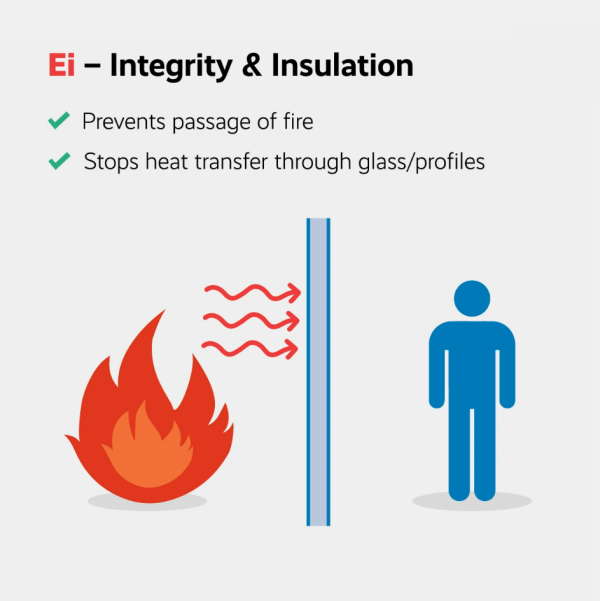Fire safety is a critical component in the design and construction of buildings.
To ensure the safety of occupants and the structural integrity of a building during a fire, fire-resistant doors and glass systems are classified according to specific ratings.
Two commonly used terms in this context are "E" and "Ei" ratings. Understanding these ratings is essential for architects, contractors, and safety professionals when selecting the appropriate fire-resistant solutions.
What is the "E" Rating?
The "E" rating stands for fire integrity. This classification measures the ability of a door or closure system to resist the passage of flames and hot gases during a fire.
An E-rated solution is designed to maintain its structural integrity, thereby preventing the fire from spreading from one area to another for a specified period, which could be 30, 60, 90 minutes, or more.

Key characteristics of an E-rated system include:
- Structural Integrity: The system remains intact during the specified duration, preventing collapse and maintaining a barrier against the fire.
- Flame and Gas Resistance: The system effectively stops flames and hot gases from passing through, limiting the spread of fire and smoke.
E-rated doors and glass systems are essential in creating fire compartments within buildings. These compartments help to contain the fire, giving occupants more time to evacuate safely and allowing firefighters to control and extinguish the fire more effectively.
To find out more about our “E” fire-rated systems click here.
What is the "Ei" Rating?
The "Ei" rating extends the concept of fire integrity by adding a requirement for thermal insulation.
An Ei-rated solution not only prevents the passage of flames and hot gases but also limits heat transfer from one side of the door to the other.
This means that during a fire, the temperature on the non-fire side of an Ei-rated door or glass system will remain relatively low, reducing the risk of ignition and injury due to radiant heat.

Key characteristics of an Ei-rated system include:
- Thermal Insulation: The system provides a barrier to heat transfer, ensuring that the temperature on the non-fire side does not exceed a specified limit, usually 140°C on average and 180°C at any single point.
- Enhanced Safety: By limiting heat transfer, Ei-rated systems reduce the risk of secondary fires and protect occupants and sensitive equipment from high temperatures.
To find out more about our “Ei” fire-rated systems click here.
Applications and Importance
E and Ei ratings are crucial in various applications within a building. For instance, in high-traffic areas such as corridors, stairwells, and lobbies, Ei-rated doors and glass partitions provide both fire integrity and thermal insulation, ensuring that escape routes remain safe and passable during a fire. In areas where the risk of fire spreading must be minimized, such as between different fire compartments or in buildings with vulnerable occupants (e.g., hospitals and schools), these ratings are indispensable.
Making the Right Choice
When selecting fire-resistant doors and glass systems, it’s essential to consider the specific requirements of your building and its intended use. An E-rated solution might suffice for areas where the primary concern is preventing the spread of flames and smoke. However, in scenarios where heat transfer could pose a significant risk, Ei-rated solutions offer an added layer of protection.
Building codes and regulations often dictate the required fire ratings for different parts of a building, ensuring that the chosen systems meet the necessary safety standards. Consulting with fire safety experts and manufacturers can help in selecting the appropriate products that not only comply with regulations but also provide optimal safety and performance.
Conclusion
Understanding the differences between E and Ei ratings is vital for ensuring comprehensive fire safety in building design. E-rated systems provide crucial fire integrity, while Ei-rated systems offer additional thermal insulation, enhancing overall safety. By selecting the appropriate fire-resistant doors and glass systems, architects and builders can create safer, more resilient buildings that protect occupants and property in the event of a fire.
Learn more about our group approach to fire rated partitions & doors.
